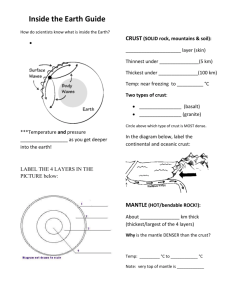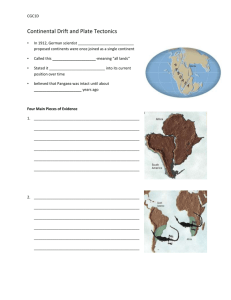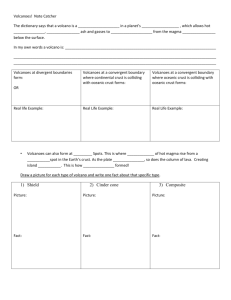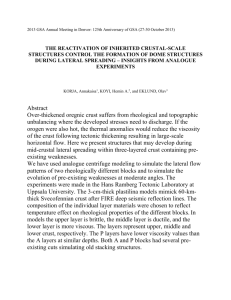File - Kepler 8th Grade - Home
advertisement
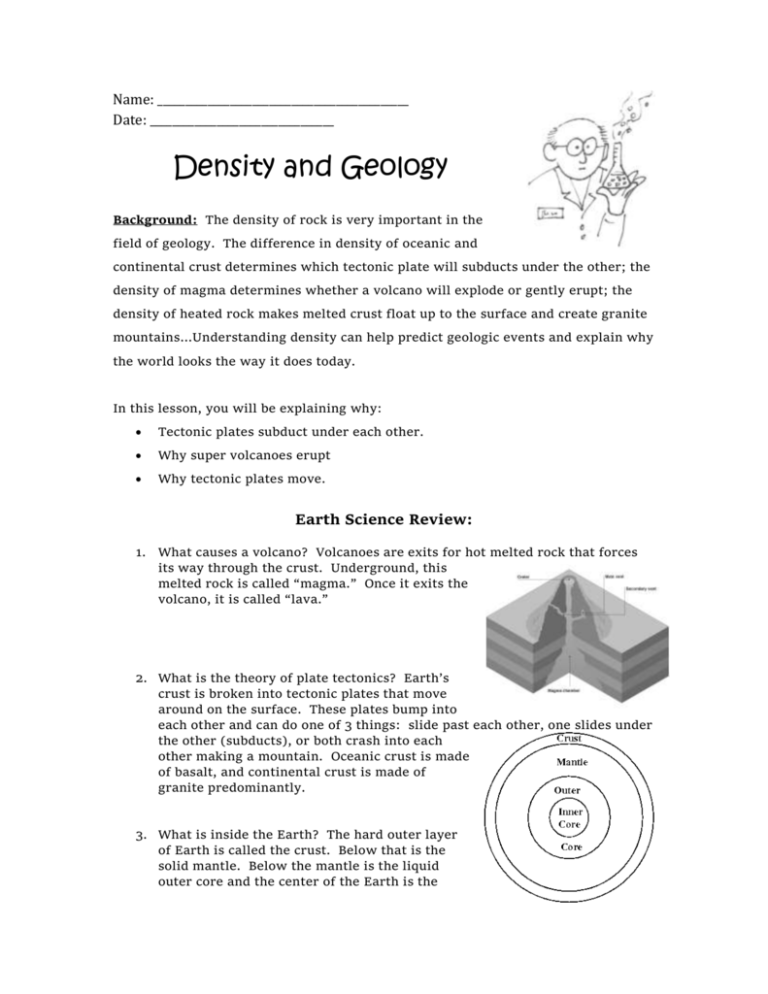
Name: _____________________________________________ Date: _________________________________ Density and Geology Background: The density of rock is very important in the field of geology. The difference in density of oceanic and continental crust determines which tectonic plate will subducts under the other; the density of magma determines whether a volcano will explode or gently erupt; the density of heated rock makes melted crust float up to the surface and create granite mountains…Understanding density can help predict geologic events and explain why the world looks the way it does today. In this lesson, you will be explaining why: Tectonic plates subduct under each other. Why super volcanoes erupt Why tectonic plates move. Earth Science Review: 1. What causes a volcano? Volcanoes are exits for hot melted rock that forces its way through the crust. Underground, this melted rock is called “magma.” Once it exits the volcano, it is called “lava.” 2. What is the theory of plate tectonics? Earth’s crust is broken into tectonic plates that move around on the surface. These plates bump into each other and can do one of 3 things: slide past each other, one slides under the other (subducts), or both crash into each other making a mountain. Oceanic crust is made of basalt, and continental crust is made of granite predominantly. 3. What is inside the Earth? The hard outer layer of Earth is called the crust. Below that is the solid mantle. Below the mantle is the liquid outer core and the center of the Earth is the inner core. The crust is the only cool layer. The other layers are characterized by increasing heat and pressure. Station 1: Supervolcanoes Instructions: Find the ars technica article online: “Earth’s devastating supervolcanoes powered by density differences” (http://arstechnica.com/science/2014/01/earths-devastatingsupervolcanoes-powered-by-density-differences/) Answer the following questions: 1. Where is there a supervolcano in the United States? ____________________________. 2. How often do supervolcanoes erupt? ___________________________________________. 3. Why does the magma in the magma chamber eventually break through the Earth’s crust? ___________________________________________________________________ ____ ___________________________________________________________________ ___________________________________________________________________ ________________________ 4. What makes supervolcano eruptions different from the typical volcano? _________ ___________________________________________________________________ ___________________________________________________________________ ___________________________________________________________________ ____________________________________ Supervolcanoes of the world. Station 2: Subducting Plates Complete the table below and then answer the questions. Type of Rock Mass Volume Density Basalt (oceanic crust) Granite (continental crust) 1. Which of the two types of crust is more dense? __________________________________ 2. Which will sink below the other when they collide? Use data above to support your answer. ___________________________________________________________________ ____ ___________________________________________________________________ ___________________________________________________________________ ________________________ 3. Predict what happens when: a. Continental crust collides with oceanic crust: _____________________________________________________________ _________ b. Continental crust collides with continental crust: _____________________________________________________________ _________ c. Oceanic crust collides with oceanic crust: _____________________________________________________________ _________ 4. When oceanic crust subducts under a continent, the plate melts when it enters the mantle. What is going to happen to the density of the crust when this heat energy is added? ___________________________________________________________________ __ ___________________________________________________________________ ___________________________________________________________________ ________________________ 5. Why do you think there are volcanoes along a subducting plate? _________________ ___________________________________________________________________ ___________________________________________________________________ _______________________ Station 3: Mantle Convection Currents Go to the following website: http://maggiesscienceconnection.weebly.com/mantle-convection-platetectonics-earthquakes--volcanoes.html Watch the first 3 videos on the right side of the screen and then answer the questions. 1. Why does hot rock near the core become less dense? (Use the words “energy” and “particles” in your answer) ____________________________________________________ ___________________________________________________________________ ___________________________________________________________________ ________________________ 2. Why does the hot rock become denser when it reaches the crust? (Use the words “energy” and “particles” in your answer.) _______________________________________ ___________________________________________________________________ ___________________________________________________________________ ________________________ 3. What do you think will happen on the surface of Earth when the core finally cools? ___________________________________________________________________ ___________________________________________________________________ ___________________________________________________________________ ____________________________________ 4. The diagram below has arrows pointing to regions of the mantle. Draw a particle diagram for each arrow.


